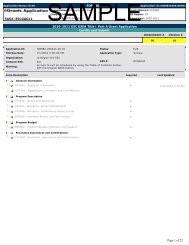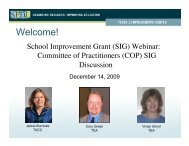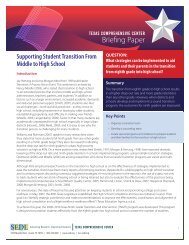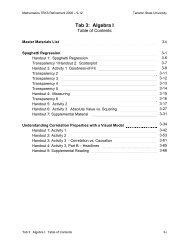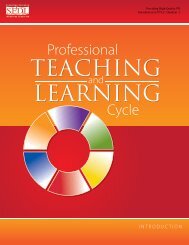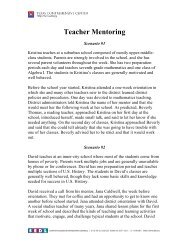The Professional Teaching and Learning Cycle: Introduction - Texas ...
The Professional Teaching and Learning Cycle: Introduction - Texas ...
The Professional Teaching and Learning Cycle: Introduction - Texas ...
Create successful ePaper yourself
Turn your PDF publications into a flip-book with our unique Google optimized e-Paper software.
<strong>Professional</strong> <strong>Teaching</strong> <strong>and</strong> <strong>Learning</strong> <strong>Cycle</strong><br />
SEDL<br />
or inexperienced teachers. <strong>The</strong> participating teachers reconvene later in a second collaborative<br />
meeting to analyze student work that was generated during the lesson <strong>and</strong> to adjust their plans<br />
for future instruction, as needed, to support student achievement.<br />
During the first year of implementation, it is recommended that collaborative teams complete<br />
at least six complete cycles of PTLC to become thoroughly familiar with the process. <strong>The</strong> first<br />
few cycles take more time because teachers are becoming versed in the process <strong>and</strong> learning<br />
their roles in each of the steps. As teams become more familiar with PTLC, they may be<br />
able to complete the last two steps of one cycle <strong>and</strong> the first three steps of the next cycle in<br />
one meeting. Two to three hours per meeting is recommended for the first year or two of<br />
implementing PTLC.<br />
how To Begin<br />
Four key roles need to be filled in order to implement PTLC successfully. <strong>The</strong> first is that<br />
of an external facilitator who can guide teachers <strong>and</strong> leaders as they become familiar with<br />
the process. <strong>The</strong> facilitator helps ensure that everyone underst<strong>and</strong>s the work <strong>and</strong> that the<br />
implementation of PTLC is aligned to the overall academic needs of the students.<br />
<strong>The</strong> second—<strong>and</strong> most important—role is that of grade-level or content-area teams of teachers<br />
who work collaboratively to carry out this process. Another role in this process is that of<br />
content specialist, filled by an individual with content expertise who provides guidance as<br />
teachers design research-based lessons that are aligned to the state st<strong>and</strong>ards. <strong>The</strong> content<br />
specialist may be the department head, an instructional coach, or a district staff member with<br />
the necessary content knowledge. <strong>The</strong> final role is for school <strong>and</strong> district leaders who monitor<br />
PTLC implementation <strong>and</strong> ensure that teachers have the support <strong>and</strong> encouragement necessary<br />
to make the process successful.<br />
An important function for all of these roles is to help build relationships <strong>and</strong> establish norms<br />
of talking to one another about issues critical to student achievement. If the school culture is<br />
not conducive to collaboration, it is unlikely that PTLC will be successful. Time <strong>and</strong> effort need<br />
to be allocated to build this capacity in order to function productively as a group.<br />
To initiate the cycle, a team should be assembled, with representatives from both the campus<br />
<strong>and</strong> the district. This group will examine various sources of data <strong>and</strong> identify a priority content<br />
area (e.g., reading or mathematics). Ideally, this should occur as part of the implementation<br />
of the Working Systemically approach, a larger systemic improvement effort. Regardless, the<br />
selection of a content area needs to be data driven <strong>and</strong> should reflect the consensus of the<br />
committee. Questions that help inform this decision include the following:<br />
• Do assessment data show areas of achievement that are lagging or disparate?<br />
• Do teachers of certain grade levels need more support <strong>and</strong> professional learning<br />
opportunities?<br />
• Are there shifts in student demographics that need to be addressed?



